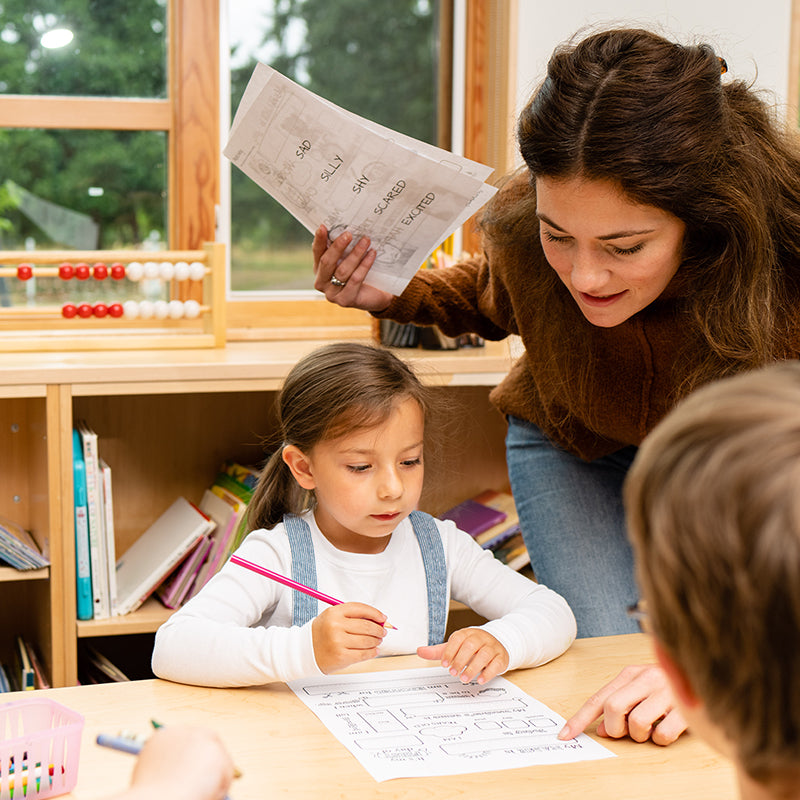When you hear the word “creativity,” what are some images and words that come to mind? Do you think of art? Paint palettes and the like? If so, you’re not alone! While creativity definitely includes the act of creating art, there’s so much more to creativity than we might at first think. We’d love to invite you on a journey to re-imagine this word with us!
We believe creativity is about the ability to generate, create, or discover new ideas, solutions, and possibilities. While we often tap into these abilities to create works of art, we believe creativity can be found in play, science, cooking, fashion, sports, language, math . . . just about anywhere! Creativity is about tapping into our own imagination, curiosity, interest, and spark. We can teach our kids that creativity is a way of being in the world that we bring with us everywhere we go.
The Benefits of Creativity
At its core, creativity is a key growth-mindset skill that allows us to create new things (inventions, solutions, etc.) from our own ideas and imaginations. Creativity helps us to solve problems, create work-arounds, and come up with new and fun ways to play.
Practicing creativity . . .
- Allows us to express ourselves
- Promotes thinking and problem-solving skills
- Reduces stress and anxiety
- Allows us to have fun
- Gives us a sense of purpose
- Encourages feelings of meaning, accomplishment, and pride
- Improves our ability to focus
- Promotes risk-taking and growth mindset for kids
- is a prerequisite for innovation
- Encourages lifelong learning
What Hinders Creativity?
We love the idea that creativity is for everyone, and we also want to acknowledge the many factors that inhibit adults and children from tapping into their inherent creative force.
When the nervous system is in a state of fight, flight, or freeze due to trauma and a lack of safety, it can be very difficult if not impossible to access a state of creativity. Sometimes, families have the ability to create safer environments for children so their creativity can flourish, but this is not always possible. Larger forces like systemic oppression, socioeconomic stress, environmental trauma, and historical trauma greatly impact many children’s safety. Implementing trauma-informed practices in your classroom can be helpful in mitigating these factors and helping students feel safe and secure in your space. Our Slumberkins Curriculum was built with this in mind.
Creativity can be a powerful healing force that offers the freedom to imagine a more equitable and inclusive world beyond current norms that allow oppressive power structures to exist. Through a creative re-imagining of our current world, we can examine and dismantle these structures and create new ones.
Tips for Promoting Creativity in the Classroom
There are lots of ways to promote creativity in the classroom (and out of it!). Here are just a few ideas:
- Offer an Open-Ended Art Prompt.
Many art activities we choose for the classroom encourage specific steps to get to an end-goal. That’s great for building specific skills like sequencing, and following directions but creativity can flourish when students have more flexibility and options of what to choose.
- Play an old game with a new twist:
For those active students, you may have activities or games you like to play in the classroom. Try giving students a chance to make up a new rule or play the game in a different way.
- Try a Science mystery:
Creative problem solving thrives with mystery. Try a science experiment where students work together in groups to figure something out.
- Encourage Building and Construction:
Some kids really show their creativity through making or building things. Whether your class is making bridges out of craft sticks or boats out of clay, give students multiple ways to show their ingenuity.
- Experience and enjoy music:
Let your students move to the music. Whether they want to dance, tap their feet or hands to the beat, or sit and enjoy the sound, give students the freedom to express themselves through the music. Another way to enjoy music that sparks creativity is drawing to the sound of the music. Encourage students to move and swirl their pencils around their paper to the sound of the music
- Create a story:
Provide opportunities for students to write in their own creative way. Whether they share a story in drawings, write a story with words, create a comic book, or tell a story aloud, creativity comes alive with storytelling.
- Problem Solving
Use a math problem and have students show their creativity in how they solve the problem. Will they use mental math, draw a picture, use manipulatives to solve the problem? Have students share their thoughts.
- Always Allow Recess and Free Time:
The benefits of free play are enormous for children. Free play and movement can really help students and their performance in school as well as their emotional-wellbeing. Try your best to preserve this time as vital for your students' learning. Remember that play has the following benefits:
- Builds imagination and creativity
- Encourages cognitive growth
- Reduces stress
- Fosters joy
- Increases self-esteem
- Improves emotional regulation
- Increases resilience and ability to recover from challenges
- Facilitates group interaction
- Encourages independence
- Promotes physical fitness
We can support and foster creativity in the classroom in so many ways. We’d love to hear your ideas and how to implement creativity in the classroom. See what your students can dream up and create!







